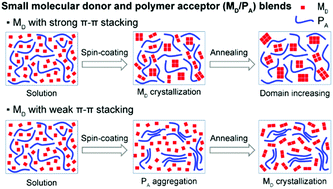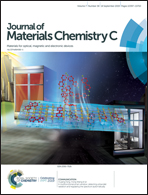Morphology of small molecular donor/polymer acceptor blends in organic solar cells: effect of the π–π stacking capability of the small molecular donors†
Abstract
Organic solar cells (OSCs) based on small molecular donor and polymer acceptor (MD/PA) blends display inferior device performance due to poor active layer morphology. However, the phase separation behaviour and morphology evolution process of MD/PA-blends are scarcely investigated and less understood. Here, the morphology of MD/PA-blends based on two small molecular donors with different π–π stacking capability was systemically investigated. The small molecular donor with strong π–π stacking crystallizes into discontinuous large domains, which disturbs the ordered aggregation of the polymer acceptor. In contrast, the small molecular donor with weak π–π stacking remains amorphous and the polymer acceptor forms ordered aggregates in the as-cast film, while post-annealing promotes the small molecular donor to crystallize into nano-sized domains, which results in interpenetrating donor/acceptor networks. Due to the improved exciton dissociation and charge transport, the MD/PA-type OSC from the small molecular donor with weak π–π stacking shows superior photovoltaic performance. These results suggest that the π–π stacking capability of small molecular donors is critical to the active layer morphology of MD/PA-type OSCs.



 Please wait while we load your content...
Please wait while we load your content...